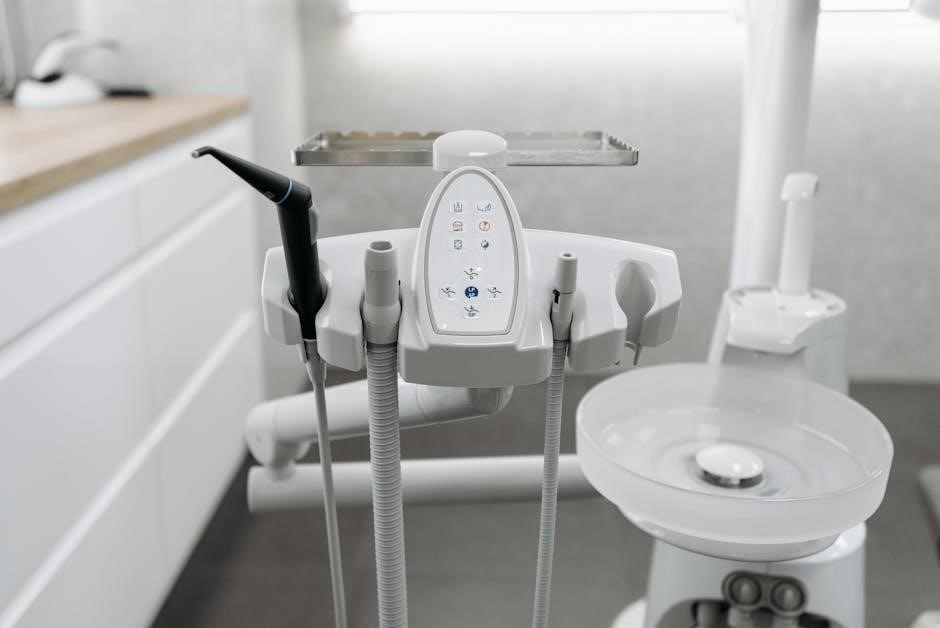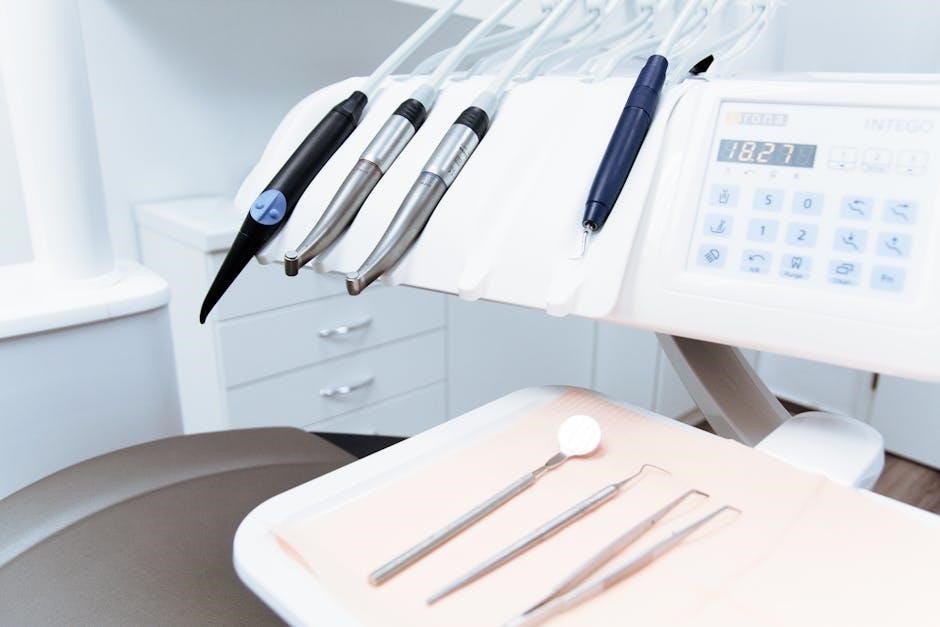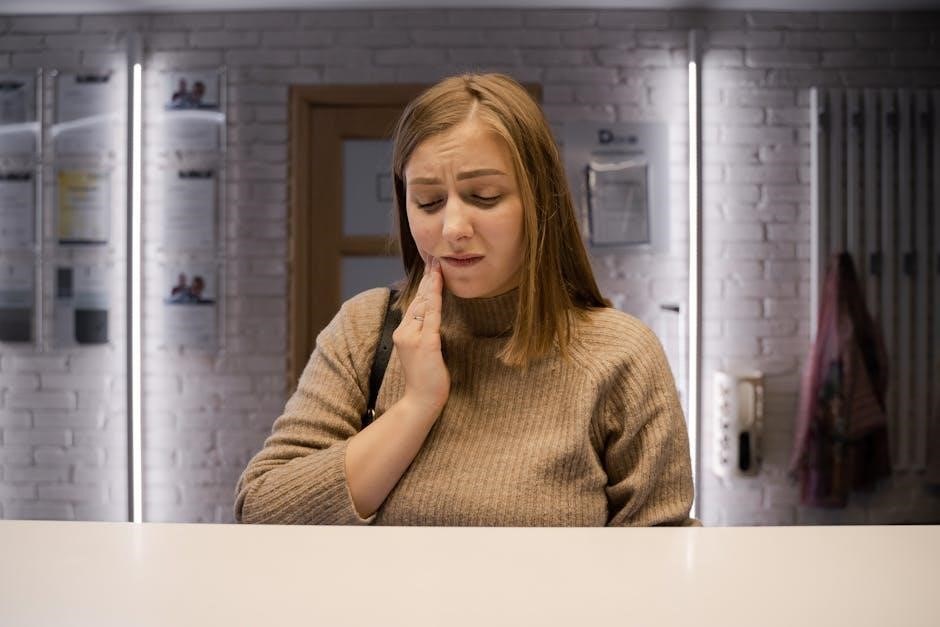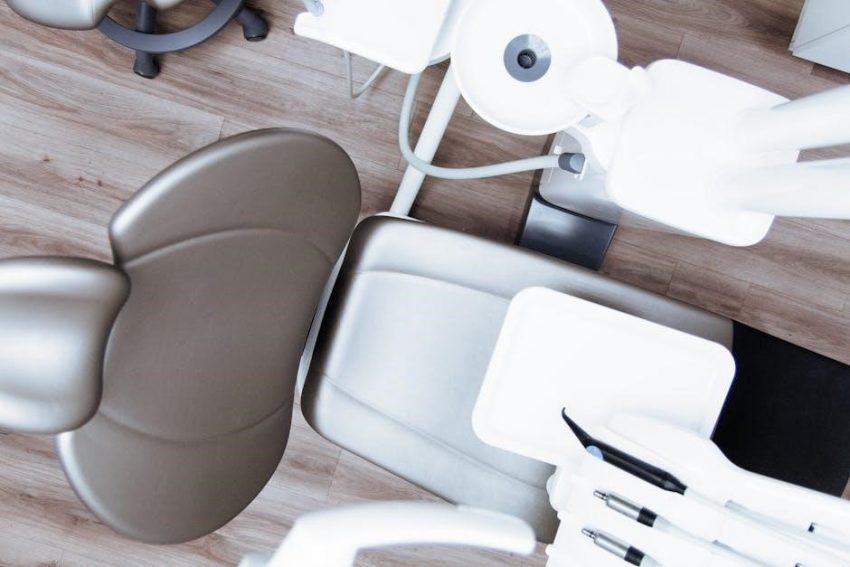The OSHA manual for dental offices provides essential guidelines to ensure workplace safety and compliance with federal regulations. It outlines policies, procedures, and standards to protect employees and patients from potential hazards, fostering a safe and healthy work environment while maintaining legal compliance.
1.1 Purpose and Scope of the OSHA Manual
The OSHA manual for dental offices is designed to provide clear guidelines for maintaining a safe workplace, ensuring compliance with federal regulations. Its scope includes establishing safety protocols, managing hazards, and outlining training requirements. It serves as a comprehensive resource for dental practices to foster a safe environment, protect employees, and adhere to legal standards while addressing specific challenges unique to dental settings.
1.2 Importance of OSHA Compliance in Dental Settings
OSHA compliance is crucial in dental settings to safeguard employees and patients from workplace hazards. Adherence to regulations minimizes risks of injuries, illnesses, and legal penalties. It ensures proper handling of biohazards, chemicals, and medical waste, while fostering a culture of safety and accountability. Compliance also protects practices from citations and enhances overall operational efficiency, making it a cornerstone of responsible dental office management and patient care.
Key Components of the OSHA Manual
The OSHA manual outlines essential components, including safety policies, hazard assessments, and required forms, to create a safe workplace and ensure regulatory compliance in dental offices.
2.1 Safety Policies and Procedures
Safety policies and procedures in the OSHA manual establish clear guidelines for dental offices, focusing on hazard prevention, emergency preparedness, and compliance. They include protocols for handling chemicals, proper use of personal protective equipment, and infection control measures. These policies ensure consistency in maintaining a safe environment for both staff and patients, aligning with legal requirements and promoting overall workplace safety.
2.2 Hazard Identification and Risk Assessment
Hazard identification and risk assessment are critical steps in ensuring dental office safety. They involve recognizing potential dangers such as biological agents, chemicals, and physical hazards. Regular workplace inspections and employee feedback help identify risks. Assessing these hazards allows offices to implement controls, reducing injury and illness likelihood. This process ensures a proactive approach to safety, aligning with OSHA standards and safeguarding both staff and patients.
Implementation of OSHA Guidelines in Dental Offices
Implementation involves developing a safety plan, designating a safety coordinator, and fostering a culture of safety and accountability. It ensures hazard identification and regular audits for compliance.
3.1 Developing a Safety Plan
Developing a safety plan involves identifying hazards, assessing risks, and creating strategies to mitigate them. It includes training employees, establishing emergency procedures, and conducting regular audits to ensure compliance. The plan is tailored to the dental office’s specific needs, ensuring a safe environment for both staff and patients.
3.2 Designating a Safety Coordinator
Designating a safety coordinator ensures effective implementation of OSHA guidelines. This individual oversees safety protocols, conducts audits, and manages compliance. They handle accident reporting, training, and emergency preparedness. The coordinator acts as a resource for staff questions and concerns, ensuring a safe environment. Their role is crucial for maintaining OSHA standards and fostering a culture of safety within the dental office.
OSHA Training Requirements for Dental Staff
OSHA requires annual training for all dental staff to ensure compliance and safety. Training covers hazard identification, infection control, and emergency procedures, with specific topics tailored to clinical and administrative roles. Regular updates ensure staff remain informed of regulatory changes and best practices, maintaining a safe workplace environment.
4.1 Annual Training Mandates
Annual OSHA training is mandatory for all dental staff, ensuring compliance with safety standards. This training covers workplace hazards, emergency procedures, and infection control. It also addresses specific roles, such as clinical staff handling biohazards and administrative staff managing records. Regular updates keep employees informed of new regulations, fostering a culture of safety and preparedness. Compliance with these mandates is essential for maintaining a secure work environment.
4.2 Specific Training for Clinical vs. Administrative Staff
Clinical staff receive training on handling infectious materials, proper use of PPE, and infection control protocols. Administrative staff focus on HIPAA compliance, OSHA documentation, and workplace safety procedures. This tailored approach ensures all employees understand their roles in maintaining safety and compliance, addressing specific responsibilities based on job functions within the dental office.

Emergency Preparedness and Response
Emergency preparedness in dental offices is critical for ensuring staff and patient safety during unexpected events. Key components include emergency procedures, equipment maintenance, and staff training.
5.1 Emergency Procedures and Equipment
Dental offices must establish clear emergency procedures, including fire evacuation plans and equipment maintenance. Essential items like fire extinguishers, first aid kits, and emergency exit signs are required. Regular inspection and staff training ensure preparedness for unexpected events, minimizing risks to patients and employees.
5.2 Fire Safety and Evacuation Plans
Dental offices must implement fire safety measures, including properly marked exits and functional fire extinguishers. Evacuation plans should outline clear escape routes and assembly points. Regular drills ensure staff readiness. Compliance with OSHA standards is crucial to safeguard employees and patients during emergencies. Updated plans and training are essential to maintain a safe environment and prevent fire-related incidents. preparedness is key to ensuring safety.

Record-Keeping and Documentation
Dental offices must maintain accurate records of workplace injuries, exposures, and safety training. Proper documentation ensures compliance with OSHA standards and facilitates audits or inspections.
6.1 Maintaining OSHA-Required Forms
Dental offices must maintain OSHA-required forms, such as injury logs (OSHA Form 300) and incident reports (OSHA Form 301). These records document workplace injuries, exposures, and illnesses, ensuring compliance with federal standards. Accurate completion and retention of these forms are critical for audits, inspections, and legal requirements. Employers should also keep accident reporting forms, filled out by employees, and store them securely for future reference.
6.2 Accident Reporting and Record-Keeping
Dental offices must maintain accurate records of workplace accidents and incidents. OSHA requires documenting injuries, exposures, and illnesses on specific forms, such as OSHA Form 300 (Log of Work-Related Injuries and Illnesses) and Form 301 (Injury and Illness Incident Report). These records help identify safety trends, ensure compliance, and support legal requirements. Accident reports should be completed promptly, stored securely, and made available for OSHA inspections or audits.

OSHA Inspections and Compliance
OSHA inspections ensure dental offices comply with safety standards, protecting employees and patients. Preparation involves maintaining records, training staff, and addressing potential hazards to avoid citations and violations.
7.1 Preparing for OSHA Inspections
Preparing for OSHA inspections involves understanding regulations, organizing required documents, and ensuring staff are trained on safety protocols. Maintain updated records, including exposure control plans and training logs. Conduct regular safety audits to identify and address hazards. Ensure emergency procedures are reviewed and accessible. Familiarize staff with their roles during inspections to promote transparency and compliance, helping to create a safer workplace and streamline the inspection process.
7.2 Understanding OSHA Citations and Violations
OSHA citations are issued when violations of safety standards are identified during inspections. Violations can be classified as serious, willful, or repeat, each carrying specific penalties. Employers must address cited violations within a designated timeframe, typically 15 days, to either correct the issue or contest the citation. Understanding the types of violations and the correction process is crucial for maintaining compliance and minimizing penalties, ensuring a safer workplace environment for all staff.

Patient Safety and Infection Control
Patient safety and infection control are critical in dental offices. Proper hygiene, sterilization, and waste disposal practices ensure a safe environment, protecting both patients and staff from infections.
8.1 Infection Control Practices
Infection control practices are essential for preventing the spread of diseases in dental settings. Proper handwashing, use of personal protective equipment (PPE), and sterilization of instruments are critical. Dental offices must follow strict protocols for handling biohazardous waste and ensuring patient safety. Regular training on infection control procedures helps maintain compliance with OSHA standards, protecting both patients and staff from potential health risks.
8.2 HIPAA Compliance in OSHA Context
HIPAA compliance within OSHA guidelines ensures patient privacy while maintaining workplace safety. Dental offices must safeguard protected health information (PHI) during safety training and emergency responses. OSHA requires employers to document incidents without disclosing PHI, balancing patient confidentiality with legal obligations. Training staff on both HIPAA and OSHA standards helps prevent violations and maintains trust in patient care environments.
Handling OSHA-Related Questions and Concerns
Dental offices can address OSHA-related questions by contacting local OSHA offices or reviewing FAQs. The ADA Guide to OSHA Compliance offers customizable templates and resources to resolve concerns effectively.
9.1 Frequently Asked Questions
Frequently asked questions about OSHA compliance in dental offices often revolve around training requirements, hazard identification, and record-keeping. Common inquiries include how often staff must receive training, which employees need specific certifications, and how to properly document incidents. Additionally, questions about HIPAA compliance in relation to OSHA standards and the proper procedures for handling chemical exposures are also prevalent; These FAQs provide clarity and guidance for maintaining a safe workplace environment.
9.2 Contacting OSHA for Guidance
Dental offices can contact OSHA for guidance through various channels, including visiting the nearest OSHA office, calling directly, or submitting inquiries via email. Employers are encouraged to seek advice on compliance, hazard assessment, and training requirements. OSHA also provides resources like FAQs and updated standards to assist dental practices in maintaining a safe environment and addressing specific concerns related to their operations and employee safety.
Best Practices for Maintaining OSHA Compliance
Adopting best practices involves implementing regular safety audits, utilizing customizable templates for compliance, and fostering continuous improvement through employee training and open communication about workplace hazards.
10.1 Regular Safety Audits
Regular safety audits are crucial for maintaining OSHA compliance in dental offices. These audits involve systematic evaluations of workplace conditions, practices, and documentation to identify and correct potential hazards. They ensure that safety protocols are consistently followed and updated, helping to prevent accidents and violations. Conducting audits annually or bi-annually, using tools like checklists, is recommended to sustain a safe environment for both staff and patients.
10.2 Continuous Improvement in Safety Standards
Continuous improvement in safety standards ensures dental offices remain proactive in enhancing workplace safety. Regular updates to policies, staff training, and equipment align with evolving OSHA regulations. Encouraging employee feedback and implementing changes based on audit findings fosters a culture of safety and compliance, minimizing risks and promoting a healthier work environment for all staff and patients.
